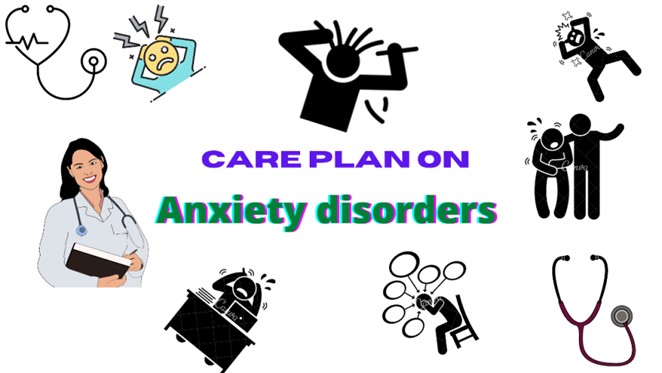Nursing Interventions and Pharmacological Treatments

- The nursing interventions for anxiety disorders are aimed at reducing anxiety, promoting coping skills, enhancing self-esteem, and improving quality of life
- Some of the nursing interventions include:
- Establishing a therapeutic relationship with the client based on trust, empathy, and respect
- Assessing the client’s level of anxiety, triggers, coping mechanisms, and support system
- Providing a safe and calm environment for the client
- Encouraging the client to express feelings and concerns without judgment or criticism
- Educating the client about the nature, causes, and treatment of anxiety disorders
- Teaching the client relaxation techniques such as deep breathing, progressive muscle relaxation, guided imagery, or meditation
- Assisting the client to identify and challenge negative or irrational thoughts and replace them with positive or realistic ones
- Helping the client to set realistic and achievable goals and reinforce small steps of progress
- Referring the client to other resources such as psychotherapy, support groups, or community services
- The pharmacological treatments for anxiety disorders are aimed at reducing the symptoms and enhancing the effects of psychotherapy. Some of the pharmacological treatments include:
- Antidepressants: such as selective serotonin reuptake inhibitors (SSRIs), serotonin-norepinephrine reuptake inhibitors (SNRIs), tricyclic antidepressants (TCAs), or monoamine oxidase inhibitors (MAOIs) that increase the availability of neurotransmitters such as serotonin and norepinephrine in the brain that regulate mood and anxiety . Examples are fluoxetine, sertraline, venlafaxine, imipramine, or phenelzine .
- Anxiolytics: such as benzodiazepines or buspirone that enhance the activity of gamma-aminobutyric acid (GABA), a neurotransmitter that inhibits anxiety and induces relaxation . Examples are diazepam, alprazolam, or buspirone .
- Beta-blockers: such as propranolol or atenolol block the effects of adrenaline and reduce the physical symptoms of anxiety such as palpitations, tremors, or sweating.
- Anticonvulsants: such as gabapentin or pregabalin modulate the activity of glutamate, a neurotransmitter that mediates excitatory signals in the brain that may contribute to anxiety.
- Antihistamines: such as hydroxyzine or diphenhydramine have sedative effects and reduce anxiety by blocking histamine receptors in the brain .
Nursing Test Bank
Quiz #1: RN Exams Pharmacology Exams
Quiz #2: RN Exams Medical-Surgical Exams
Quiz #3: RN Exams Fundamentals Exams
Quiz #4: RN Exams Maternal-Newborn Exams
Quiz #5: RN Exams Anatomy and Physiology Exams
Quiz #6: RN Exams Obstetrics and Pediatrics Exams
Quiz #7: RN Exams Fluid and Electrolytes Exams
Quiz #8: RN Exams Community Health Exams
Quiz #9: RN Exams Promoting Health across the lifespan Exams
Quiz #10: RN Exams Multidimensional care Exams
Naxlex Comprehensive Predictor Exams
Quiz #1: Naxlex RN Comprehensive online practice 2019 B with NGN
Quiz #2: Naxlex RN Comprehensive Predictor 2023
Quiz #3: Naxlex RN Comprehensive Predictor 2023 Exit Exam A
Quiz #4: Naxlex HESI Exit LPN Exam
Quiz #5: Naxlex PN Comprehensive Predictor PN 2020
Quiz #6: Naxlex VATI PN Comprehensive Predictor 2020
Quiz #8: Naxlex PN Comprehensive Predictor 2023 - Exam 1
Quiz #10: Naxlex HESI PN Exit exam
Quiz #11: Naxlex HESI PN EXIT Exam 2
Questions on Nursing Interventions and Pharmacological Treatments
Correct Answer is C
Explanation
Developing measurable and realistic outcomes is an important aspect of the therapeutic process, but it is not the primary goal of establishing the therapeutic relationship. Measurable outcomes come after working through various therapeutic interventions.
Correct Answer is ["A","D"]
Explanation
<p>Guided imagery is another suitable relaxation technique. It involves using mental visualization to create calming and peaceful images in the mind. Guided imagery can divert the client's attention away from stressors, promoting relaxation. This technique has been shown to reduce anxiety and promote a sense of well-being.</p>
Correct Answer is A
Explanation
<p>Minimizing anxiety by stating that "Anxiety is not a big deal, everyone feels it sometimes" is dismissive of the client's emotions. It invalidates their experience and fails to acknowledge the impact anxiety may have on their well-being. Providing empathy and understanding is crucial in therapeutic communication.</p>
Correct Answer is C
Explanation
Advising the client to rely on friends and family for support instead of seeking professional help minimizes the importance of therapeutic interventions. While social support is valuable, it is not a substitute for evidence-based treatments for anxiety disorder.
Correct Answer is D
Explanation
Enhancing the activity of serotonin and norepinephrine is the correct mechanism of anxiolytics. Medications like SSRIs (Selective Serotonin Reuptake Inhibitors) and SNRIs (Serotonin-Norepinephrine Reuptake Inhibitors) work by increasing the levels of these neurotransmitters in the brain. Serotonin and norepinephrine play critical roles in mood regulation and anxiety modulation.
Referring to support groups can be valuable for clients with anxiety disorders, but it doesn't directly involve teaching coping skills or enhancing self-esteem. Support groups provide social connections and a platform for shared experiences.
Diphenhydramine is an antihistamine commonly used for allergies and as a sleep aid. It's not a standard pharmacological treatment for anxiety disorders.
D dismisses the client's worries and could invalidate their feelings. It's important to avoid belittling the client's concerns, as it may hinder the development of a trusting nurse-client relationship.
This statement invalidates the client's feelings and suggests that anxiety is insignificant. It fails to acknowledge the client's experiences and discourages open expression.
Impairment in personal domains is a negative outcome. Nursing interventions aim to improve functioning and minimize impairment, so this choice contradicts the therapeutic goals.
Generalized anxiety disorder (GAD)
Search Here
Related Topics
More on Nursing
Free Nursing Study Materials
Access to all study guides and practice questions for nursing for free.
- Free Nursing Study Trials
- Free Nursing Video tutorials
- Free Nursing Practice Tests
- Free Exam and Study Modes
- Free Nursing Revision Quizlets
